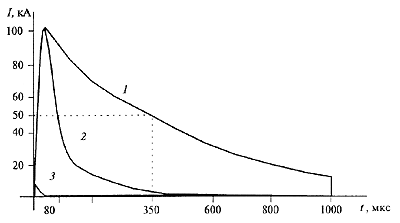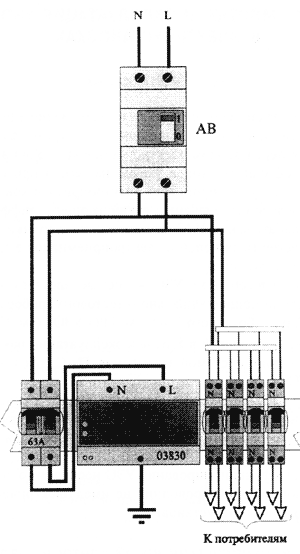13. Principles of Execution of Overvoltage Protection
13.2. TECHNICAL PARAMETERS OF DEVICES FOR PROTECTION AGAINST OVER-TERMINALS
As an example, in Table 13.1 and in Fig. 13.2. The parameters of the current test pulses for testing the equipment in accordance with classes 3 and 4 are given.
Table 13.1
| Parameter / Impulse | 1 | 2 | 3 |
| I max , kA | 100 | 100 | 5 |
| W / R (specific energy), J / Ohm | 2.5 * 10 6 | 5 * 10 5 | 0.4 * 10 3 |
| Q max , Cl | 50 | 10 | 0.1 |
| Pulse shape, microseconds | 10/350 | 8/80 | 8/20 |

Figure 13.2. Test impulses
For protection against impulse overvoltages, gate dischargers, calibrated spark gaps, various types of nonlinear resistances, varistors and their combinations are used. Further, for simplicity of presentation, the term "security element" will be used as a generalization.
Protective elements according to IEC classification by purpose and parameters are divided into classes A, B, C and D.
Class A. Designed for installation in low voltage distribution networks. They are tested by shock current 3 (Table 13.1).
Class B. They are intended for systems of equalizing thunderstorm overvoltages and protection from direct lightning strikes. They are tested by shock current 1 (Table 13.1).
Class C. They are intended for protection against impulse overvoltages in stationary electrical installations and are installed in the input distribution panels. They are tested by shock current 3 (Table 13.1).
Class D. Designed for protection against impulse overvoltages in stationary and mobile electrical installations and installed in outlets or directly at the consumer. They are tested by complex voltage pulses of 1.2 / 50 and a current of 8/20 μs.
The well-known European manufacturers of surge arresters of various systems are the companies: DEHN, ABB, INDELEC, LEGRAND, ISKRA, CITEL, EFEN, OBO BETTERMANN and others.
In Fig. 13.3 is a diagram of the power supply of an electrical installation with the TN-CS grounding system and surge protection devices recommended by DEHN.

Fig. 13.3. Power supply scheme of electrical installation with TN-CS grounding system and DEHF overvoltage protection devices
The circuit of the input switchgear with the device for protection against lightning overvoltage, recommended by LEGRAND, is shown in Fig. 13.4.

Fig. 13.4. Scheme of the input switchgear with the lightning surge protection device LEGRAND
In Russia OPZ MEI released the first batch of surge arresters type ASTRO * OPN-12 / 0.4. In Table. 13.2 shows its main technical data. Surge suppressor non-linear ASTRO * OPN-12 / 0,4 is designed to protect against lightning and switching overvoltages of electrical installations, in networks 380/220 V AC frequency of 50 Hz. Limiters ARF are designed for indoor installation of climatic performance UHL 4.
Table 13.2
| No. | Parameter name | Nominal value |
| 1 | The voltage U n , V | 380 |
| 2 | The maximum allowable voltage of the arresters is U ef , V | 400 |
| 3 | Rated discharge current (8/20 μs), kA | 10 |
| 4 | The remaining voltage at a current pulse, not more than В | |
| 250 A, 8/20 μs (U 250 ) | 1000 | |
| 250 A, 30/60 μs (0.995U 250 ) | 995 | |
| 2500 A, 8/20 μs (0.18 U 250 ) | 1180 | |
| 5000 A, 8/20 μs (1.26U 250 ) | 1260 | |
| 5000 A, 1 / 2.5 μs (1.35U 250 ) | 1350 | |
| 10000 A, 1 / 2.5 μs (1.35U 250 ) | 1350 | |
| 5 | Classification voltage Ucl (amplitude value of a sinusoidal voltage of frequency 50 Hz at the amplitude value of the current through the arresters 1.5 mA), V | 710 |
| 6th | The maximum discharge current (4/10 μs), kA | 50 |
| 7th | Maximum energy absorbed during switching overvoltage, kJ | 0.8 |
| 8 | Throughput of surge arresters, actions (rectangular current pulses of duration 2000 μs with an amplitude of 250 A for 2-3 exposures with an interval of 50-60 s, followed by cooling to ambient temperature of 20- + 15 0 С | 20 |
| 9 | Overall dimensions (one module, fixing on DIN-rail), mm | 17.5x75x80 |
The limiter is a spark gap without spark gaps, the active part of which consists of metal oxide nonlinear resistors (MHP) with a highly nonlinear volt-ampere characteristic.
The protective effect of the surge suppressor is based on the leakage through it when dangerous overvoltages occur (due to the highly nonlinear volt-ampere characteristic of the MPR), the pulsed current to the grounding device, which reduces the overvoltages to a safe value, at which the insulation of the electrical equipment does not break down.


Comments
When commenting on, remember that the content and tone of your message can hurt the feelings of real people, show respect and tolerance to your interlocutors even if you do not share their opinion, your behavior in the conditions of freedom of expression and anonymity provided by the Internet, changes Not only virtual, but also the real world. All comments are hidden from the index, spam is controlled.